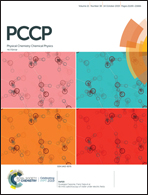Large scale quantum dynamics investigations on the sensing mechanism of H2O, acetone, NO2 and O3 adsorption on the (MA)2Pb(SCN)2I2 surface†
Abstract
The instability of organometal halide perovskites still remains a key obstacle restricting their practical application in gas sensing research. The first step in gas sensing using a semiconductor material is the recognition of a target gas through gas–solid interaction. In the current work, the adsorption mechanisms of MAPbI3–H2O, (MA)2Pb(SCN)2I2–H2O, (MA)2Pb(SCN)2I2–CH3COCH3, (MA)2Pb(SCN)2I2–NO2 and (MA)2Pb(SCN)2I2–O3 have been investigated by large-scale quantum dynamics simulations. The structural changes of the perovskite skeleton, the adsorption energy, and the charge transfer between the semiconductor material and the gas molecules have been analysed. The suitability and effectiveness of quantum dynamics simulations in adsorption mechanism research are firstly validated by comparing the humidity sensing mechanisms of MAPbI3 and (MA)2Pb(SCN)2I2. Different sensing mechanisms of (MA)2Pb(SCN)2I2 to gases with different oxidising properties have been proposed. These sensing mechanisms hopefully lay a foundation for the development of novel perovskite gas sensing materials with enhanced stability, high sensitivity, and high selectivity.



 Please wait while we load your content...
Please wait while we load your content...